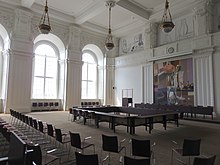Landsting (Denmark)
Supported by (1) Opposition (39) Faroe Islands The Landsting (Danish: Landstinget) was the upper house of the Rigsdag, from 1849 until 1953, when the bicameral system was abolished in favour of unicameralism.Membership of the house was then restricted to certain sectors of society: only males with a certain net worth could hold a seat.The number of members was increased to 66, of whom 12 were appointed by the king for a period of twelve years, and one by the Faroese Løgting.[4] As the main direct tax of the time was based on real estate and its value as farmland, this system greatly favoured manor owners.[7] Although a 1939 referendum that would have replaced the Landsting with another chamber—the Rigsting—and simplified the legislative process, this failed due to a low voter turnout, and the bicameral system survived.

Landsting (disambiguation)BicameralismSpeaker of the LandstingVenstre – Liberal PartyConservative People's PartySupported byJustice Party of DenmarkOppositionSocial DemocratsRadikale Venstre – Social Liberal PartyVoting systemIndirect voting1953 Danish Landsting electionDanishupper houseRigsdagbicameralunicameralismFolketingconservativesChristiansborg PalaceassemblyVikingfreemenclan-based societyScandinaviamediationParliament of GreenlandConstitution of 1849right to voterequirements for electabilityconstituencystaggeredthe kingFaroeseLøgtingCopenhagenparishmarket townsdirect taxreal estatefarmland1902 election1918 electiongiven the right to voteInger Gautier SchmitNina BangMarie ChristensenMarie HjelmerOlga Knudsen1939 referendumvoter turnoutreferendum held that yearDanish politicsGovernment of DenmarkGovernment of the Faroe IslandsGovernment of GreenlandList of speakers of the FolketingDanish Ministry of Foreign AffairsDanish Ministry of EducationElections and referendums in DenmarkFolketing elections1853 (Feb)1853 (May)1866 (Jun)1866 (Oct)1881 (May)1881 (Jul)1920 (Apr)1920 (Jul)1920 (Sep)1953 (Apr)1953 (Sep)Landsting elections1920 (Aug)1920 (Oct)European electionsLocal electionsConstituent Assembly 1848